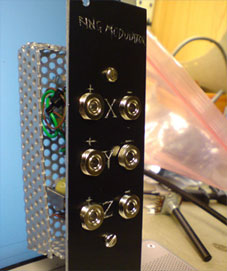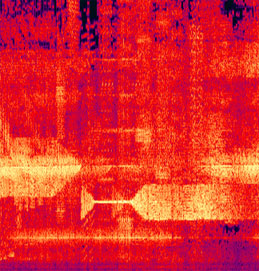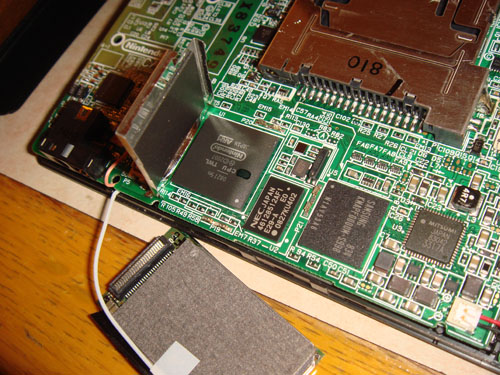MTVE fined for airing uncensored version of “Windowlicker”
November 24th, 2008
MTV Networks Europe was fined £255,000 (US$484,500 = €385,000 = 18,411,000,000 Zimbabwe Dollars) for playing the uncensored version of the 1999 video “Windowlicker” before the 9PM timeslot. It’s unknown how it happened, but I bet someone has or will get fired for it.
The video is a parody of pimped out hiphop videos and contains a high amount of profanity and possibly disturbing imagery. The video was directed by the genius Chris Cunningham and was nominated for the “Best Video” award at the BRIT Awards 2000. If you haven’t watched it before, do it right now!
If you’re completely unfamiliar with Aphex Twin, the cover art for the single should give you an idea about his twisted (and beautiful) mind:

Oh, and if anyone knows where the phrase “J’aime faire de croquettes aux chiens” comes from originally, please tell me!
Gameboy Art by Tom Markey
November 24th, 2008Tom Markey
Gameboys.
I wouldn’t exactly call it a series yet. More of just tests or samples, but i can’t stop doing work involving them so maybe very large series on the way?
Drawings. Other artsy lo-fi stuff. That’s what Tom Markey is doing. And some LSDj tunes. Go check it out.
Download: Quarta330, live at Back To Chill, Tokyo
November 22nd, 2008
Whether you honoured the nihilistic ritual No Music Day or not, you should check out this liveset by Japan’s Gameboy Dub warrior number one. He’s a genius, not only in composition, but sound design. He manages to get a sound that’s sooo crisp, yet so smooth.
The rest of the stuff on that page is pretty good too. It’s mostly livesets/dj mixes of tasteful electronic music like dubstep and other styles.
Zeitgeist: Addendum
November 22nd, 2008
I watched Zeitgeist: Addendum not long after it was released, but I haven’t gotten around blogging about it until now. What made me do it was the blog post by Tim Exile, a music producer who’s using Reaktor to do wicked stuff, whom I respect and admire. He’s soon to release a new album which is different from his previous raw DnB/techno. I have yet to decide whether I like it or not.
Anyway, for those of you who don’t know, Zeitgeist: Addendum is an addendum to the documentary Zeitgeist, and where the original movie analyzed religion and human nature in general, the addendum analyzes modern economy and banking. It’s divided into four parts, and I will not go into detail what each part is about, but I recommend you to watch the movie, despite my criticism towards it.
I also recommend anyone who has watched or will watch it to read this blog post which talks about a number of things I thought about when watching ZG: A, but didn’t really know how to express. Do not just read the post, read the comments as well. A lot of great points are being made there.
The following can also serve as a summary of Point’s post.
- Currency is not the same thing as money. - Money is anything with value that can be traded. It’s simply another word for value. Currency is a concept for organizing value. No matter what political and financial system is in place, there will always be a market where people can buy what they want. Currency is certainly not the only kind of money; goods, services, gold, power and violence are other likely candidates in a system without currency. And even if today’s currency system is flawed, it’s not an argument why the general concept of money should be abolished. (In fact, it can’t, unless resources are completely abundant)
- Capitalism is not the same thing as imperialism. - Part 2 of the movie goes on to link economy with corruption by listening to the confessions of a so called “economic hitman”. The problem here is not the accuracy of his accounts - I’m sure each sory is accurate en ough - but the confusion between capitalism and imperialism. What causes large scale corruption is ultimately imperialism - concentration of power. It might true that capitalism implies imperialism, but so does just about any political system. The phrase “Even the Romans” might seem like a cliché but is in fact very relevant. Corruption has always existed and will always exist. By removing capitalism, we do not remove imperialism, we just make it change forms, since every political system implies imperialism.
- Human desire is unlimited. - I’ll copy and paste a quote from the comment section of the blog post I linked to above.
Money is a concept, not an object. It is anything that can be exchanged for something you want, and human desire is unlimited. There will always be something people want beyond what they have, sometimes it’s a physical object and sometimes it’s not. There is no way all of those desires can be satisfied for all people so somebody will always be deprived of something and willing to trade to acquire it, and thus money will never go away. Making stuff abundant is technically the same as making money scarce, you will only make it more valuable by making it more difficult to find items or services that people are willing to accept in exchange for the stuff they trade. And the idea that resources on this planet are unlimited is absolute nonsense. Go watch Chris Martenson’s “Crash Course”. Google that.
My advice is to both watch the Zeitgeist: Addendum and read that blog post, and most importantly, approach both with caution and use your critical thinking.
24 Watt Bicycle LED Light
November 13th, 2008I stumbled upon this link earlier today. Probably the strongest bicycle lights I’ve ever seen. It’s a 24 Watt lamp, but the twist is that it’s made with ultra bright LEDs. If you’ve used one of these, I bet you won’t go back to the old piss poor standard bicycle lamps. If I were to start riding a bike in the woods, I’d probably build one of these.
Not only is it useful, but the images are pretty neat. It gives the Finnish woods a pretty eerie feeling. (Scroll down to the bottom of the source page for more)
Source: 24-wattinen led-valaisin (Finnish)
Google Translation
10% discount on Gameboy gear from Nonfinite Electronics
November 11th, 2008
Nonfinite Electronics recently teamed up with CrunchyCo, an independent group of inspired individuals who are into lo-fi music and arts. To celebrate this, Nonfinite is offering a 10% discount on all of his products. (He has everything from Prosounded backlit Gameboys to Gameboy flash cartridges in his shop.)
But hurry, the discount is only valid for two weeks from now! The coupon code for the discount is available at www.crunchyco.com.
Gameboy Prosound Tutorial
November 11th, 2008
xero/the.fontvir.us has just released a DMG Prosound tutorial. His tutorial is pretty much foolproof. (Or shall I say n00bproof?)
For those of you who don’t know, Prosound is the name given to a modification done to a video game system to improve the sound. (Important for chip musicians!) Typically it’s appplied to a Gameboy, but people have done similar mods to systems like NES and Sega Master System 2. A prosound mod usually works by bypassing any audio amplifier in the console, which works well for use with a mixer, but not so well when plugging in headphones directly into it. (But you can keep the original jack for use with headphones)
Pictures from inside the DSi
November 9th, 2008There have been a lot of posts about Nintendo’s new handheld the DSi on my blog lately, because I’m following the unveiling of information about it closely. This link is one day old, which is ancient in this context.
Bunnie:studios has opened his (her?) DSi and commented the guts. I especially like the comment “Mainboard backside photo — love the detailed, plain-English “hack here please” silkscreen annotation”
The CPU is unmarked. (It only says ARM 2007) While Bunnie speculates that the clock could be in the range of 266-533 MHz, I as the cynical/pessimist I am still guessing it’s the same 66 MHz ARM9 as in the original DS’s. I’ll gladly be proven wrong though. Decipher the marking on the clock crystal. Measure the clock with an oscilloscope/other equipment. Hack it and run some sort of BogoMIPS routine. Anything! Just prove me wrong, and I’ll be a much happier guy. ![]()
Time will tell, I suppose.
Anyway, Bunnie’s blog seems pretty interesting, so I’ve subscribed to it. I’m hoping to see more of the “Name that Ware” segment, and perhaps a little more on the trip to Japan?
New DSi hack video from Yasu!
November 9th, 2008
Just a few days after his first video of a simple “Hello world” program running on the DSi, Yasu posted a video of the DSi running his own Beatmania-like software BMDS. Still no clues of how he did it though. ![]()
Source: http://home.usay.jp/pc/etc/nds/
(The video wasn’t available on youtube, only in mpg from his site, so I uploaded it.)
Veqtor: Analogue vs Digital
November 8th, 2008

My friend Veqtor is building a modular synth, but so far he’s only got two modules, a Doepfer A-143-2 Quad Envelope and a passive ring modulator. (That I helped build) No fun? Wrong!
Listen to the sound clip in his blog post!
The envelope can be turned into an LFO by using feedback where a step in the envelope retriggers the the envelope. (Ie, “when reaching sustain, retrig”) The resulting waveform varies between triangle and sawtooth, depending on the attack and decay.
And as can be seen, the ring modulator has, not only the usual X, Y, Z, but each of them has a + and - port, totalling 6 in/outputs. This was my idea, and it works like this: When only one of the +/- ports of one group is connected, it works like a regular ringmod. When both a + and - are connected, the signal pins of the respective signal pins of those inputs are connected to the respective poles on the ring modulator. Or to put it another way, the - input is connected to where Ground would normally be connected. This is ok since the transformers make each group (X, Y, Z) electrivally isolated.
The result is that the - input is subtracted from the + input. For example, it’s interesting to route a signal with an effect on + and the same signal dry on -. (Filters and phase effects work the best) As for the output, you can, eg, connect Z+ as an output (As usual) and connect Z- as an input. We haven’t tried this yet, but I’m sure it will sound interesting…
As for Veqtor’s blog post, he goes on to discuss the difference between analogue and digital synthesis, and where each one. An analogue synth has a certain quality to it (In the neutral sense of the word) which is hard to emulate, whereas audio can be processed digitally in ways that analogue synths and effects can’t do it.
When creating the clip in the blog post, he was using, among other digital effects, PSP Nitro. I will hereby take the opportunity to say that I’ve always thought the name of this plug is a bit ironic, since PSP=Playstation Portable and Nitro is the code name that was used for Nintendo DS. Yeah, I know. That’s a very obscure thing to notice, but I had a little laugh about it when I first saw it. Of course it’s completely unintentional from their side. ![]()
![You suck at protoshop. No, you [i]really[/i] oo.](http://blog.gg8.se/images/you-suck-at-photoshop-you-really-do-your-awful.png)






